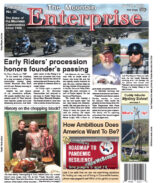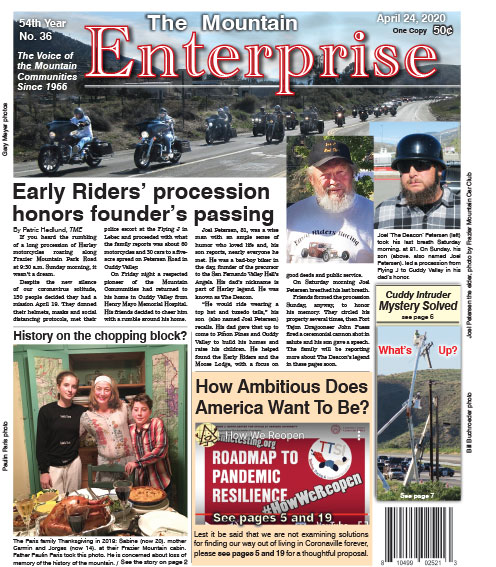Comment by Patric Hedlund, TME Managing Editor
America is Number One again. By this time next week, it is likely that a million Americans will have been diagnosed with covid-19—more than anywhere else in the world. As of today, Americans who have died of it is close to 60,000. That number is rising.
Gratefully, due to radical social isolation, only five of those deaths are in Kern County so far, out of 856 cases—502 of those between ages 18-49. [updated April 29, 2020] This pandemic is real. A war is being fought in the nation’s hospitals. Medical professionals are still courageously on the front lines—still becoming sick, still dying.
Securing a dependable supply stream of personal protective equipment (PPE) has become a monstrous Wild West Rodeo of predatory Chaos Capitalism at its most raw—complete with double agents, 900% mark-ups on face masks by middlemen and scammers, states bidding against states, hospitals against hospitals, with rural regions left in the dust.
California’s Governor Newsom is drawing political fire for wrangling a secretive billion-dollar PPE mask manufacturing deal with a Chinese firm that has an electric car subsidiary in Lancaster. The goal? To supply 200 million masks a month for California’s frontline workers.
Secrecy is wise, America’s governors have learned, because our own federal government has opted not to use its emergency powers to coordinate orderly manufacture and distribution of lifesaving PPE stamped “Made In America.”
Instead, the federal government has been intercepting and stealing the states’ PPE supply shipments for the federal stockpile, then hoarding them or handing them out as favors.
Meanwhile, local heroes in homes right here on the mountain, the quilters and lacemakers we enjoy calling The Masked Scrappers, have made and donated over 700 surgical masks to healthcare workers at regional hospitals that provide services to our local residents. Their underground railroad brings elastic ties, fabric and other supplies to the Scrappers, then Mel and Kathleen Weinstein pick up masks from the front steps of homes and deliver them to the hospitals. Lacemaker and quilter Liz Buchroeder publishes a daily Scrappers Blog filled with manufacturing tips and morale-boosting humor.
••••••••••••••••••••••••••••••••••••••
You know what dying of tobacco-related illnesses doesn’t do?
It doesn’t kill your nurses.
••••••••••••••••••••••••••••••••••••••
Heroic sacrifice by you, me and shuttered small businesses around this state have succeeded in flattening the covid-19 contagion curve. But in urban centers and specific rural hot spots, intensive care units are still battling the spike, or getting ready for the second wave that will be coming if we are not wise.
Ample and Affordable Testing—with Antibody and RNA Tests—Are Vital Now
Now the conversation is shifting to testing. Why? Because it must.
There are two kinds of tests. RNA tests are a snapshot of this moment, to tell you if you have the SARS-CoV2 virus (that causes covid-19) in you, at this instant. You can get the test at 1 p.m., then contract the virus at 1:10 p.m. and the test will tell you only your status when that swab was taken at 1 p.m. Optimally, the RNA test would be available often and affordably.
The second test is called the antibody or antigen test. It tells whether you have already had SARS-CoV2 in your body and have developed immune system resistance that may show up as antibodies in your blood. There is still much to learn about these antibodies and whether or not they are a full defense against getting sick with covid-19 again.
New studies in Santa Clara County and Los Angeles indicate that the numbers of asymptomatic coronavirus carriers among us—who may be us, you and me—are far higher than scientists had dreamed was possible—maybe as much as 28-50% higher.
To repeat: These are innocent people who carry the virus causing covid-19 and don’t know it, who can spread it widely, but show no symptoms or feel only mildly under the weather. Add to that, there is news this week that clinical data now shows those who get sick with covid-19 are actually most contagious two to three (2-3) days before they have their first symptoms.
The only way society can safely begin to open back up is by knowing quickly and affordably whether it is safe…whether we are safe…whether others are safe around us. Now we hear politicians talking about “opening up the American economy” while the scientists beside them display charts showing the second wave of the pandemic can be twice as intense as this first one.
A brilliantly direct report was issued by the Safra Center for Ethics at Harvard University this week, under leadership of Danielle Allen, PhD: “The Roadmap to Pandemic Resilience.”
This is the question we all need to be asking now:
OpEd: How Ambitious Does America Want to Be?
By Danielle Allen, PhD Director, Edmond J. Safra Center for Ethics at Harvard University
“We believe we need to be doing 5 million tests a day by June”
Doubling testing will help. Tripling testing will help. But those levels will not get us to a level to let us avoid a second wave of the covid-19 pandemic. How much testing, tracing and supportive isolation do we need to avoid having to use repeated applications of stay-at-home orders when the second and third wave hits? Our view is that we need to get to five million tests a day by early June to achieve that. It is doable. You don’t have to break any laws of physics to do this.
Among the top recommendations in “The Roadmap to Pandemic Resilience” to help ensure a safe social opening is to increase from the five million tests a day to 20 million tests per day by mid-summer, to be able to fully re-mobilize the economy.
Without a fully considered strategy it will be impossible for businesses to plan. They won’t know if they can count on their business partners to stay open, or whether their workers will all get sick at the same time.
Avoid the ReOpen Rollercoaster
We would be on the ReOpen Rollercoaster. Opening and having to close down, opening and closing down again. That won’t work.
We need to be able to rebuild trust in our personal safety to re-mobilize the U.S. economy.
Four-Phase Plan
The First Phase has three important elements.
It looks something like this:
Number 1 is More Testing, with fast tests, ramped up to a massive scale so you monitor how you are doing.
Number 2 is Contact Tracing, so you can find out fast, and if you test positive, you will be able to alert all those who may have been affected.
Number 3 is Supported Isolation. If you test positive you will know you can go into isolation with medical care, necessary supplies and job protection. You won’t have to worry if you are spreading the disease without knowing it. And with paid sick leave, no one is worried about being fired for getting sick. This will also be a tool to help provide greater protection to people in nursing homes and institutions.
Testing, Tracing and Supported Isolation is possible, but it takes resources: about $200 to $500 billion over two years.
The plan we’ve developed is set up to be able to begin opening the country again by this summer. Right now, 40% of the economy is already open with essential workers, such as nurses, hospitals, grocery store workers, [news reporters!], food workers, utility workers, firefighters, law enforcement, restaurant and delivery workers. They didn’t ask to be put on the front line of this crisis. But there they are. We are all grateful to them.
Phase Two expands from that 40% base of essential workers to 70% of the workforce, to address supply chain problems (and to be able to find toilet paper on store shelves again). Social distancing and masks continue. We are expanding testing. People can feel confident about their own health.
Phase Three is when nonessential businesses like hair and nail salons will reopen, wearing masks. These personal services make social distance difficult, but social distance will still be observed at other times. Many of us office workers and mathematicians still will be working at home. This phase will take place in about July. Rigorous testing continues.
Phase Four allows the last 20% of the economy to be able to go back to the office again, but rotating, so that social distancing is still possible. Students can go back to school, but with changes that will allow social distancing.
Enough tests will mean that sports teams will be able to play for television audiences again, and athletes will be able to be tested every day.
While Waiting for the Vaccine to Arrive
It has been predicted that a vaccine will take about 18 months to be safely developed.
The Four-Phase plan above will get us into that second year without slipping back into the ReOpen Rollercoaster.
Things will be a little different, but imagination will help us discover how we can start getting back to more normal activities while still using social distancing as we are waiting for that vaccine to arrive.
It can be done.
This is “Can Do” America. The real question remains, “How ambitious does America want to be?”
Allen is Director of Edmond J. Safra Center for Ethics at Harvard University.
—Synopsized by
Patric Hedlund, TME
See a video presentation about the plan
The Roadmap has just been released this week.
Note from Danielle Allen:
Our bipartisan group of experts in economics, public health, technology and ethics from across the country, with support from The Rockefeller Foundation, has released the nation’s first comprehensive operational roadmap for mobilizing and reopening the U.S. economy in the midst of the covid-19 crisis:
“The Roadmap to Pandemic Resilience.”
This is part of the April 24, 2020 online edition of The Mountain Enterprise.
Have an opinion on this matter? We'd like to hear from you.


